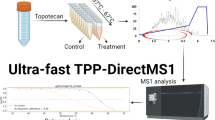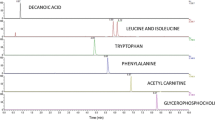Abstract
Proteomic research is currently used worldwide for search biomarkers of different types of cancer. However, the assessment of the changes in proteomic profiles that are not associated with the progress of pathology is also an important task of clinical proteomics. This problem can be solved by developing a reproducible and exact method for profiling serum from healthy humans. The technologies of prefractionation of human serum samples by magnetic beads MB WCX and MB IMAC Cu using ClinProtrobot (Bruker Daltonics) and microchromatographic zip-tips prior to direct mass-spectrometric profiling were tested. Quality control was performed for all of the obtained spectra, with elimination of drastically different samples from the total data set, and the variation coefficient was calculated for each sample preparation technology. The study has demonstrated that the most reproducible method of serum prefractionation is the pretreatment of samples with magnetic beads MB WCX, which show the lowest number of ineffectual spectra and low variation coefficient (CV = 0.19) as compared with MB IMAC Cu (CV = 0.26) and zip-tip microcolumns (CV = 0.40).
Similar content being viewed by others
References
Banez, L.L., Prasanna, P., Su, L., et al., Diagnostic Potential of Serum Proteomic Patterns in Prostate Cancer, J. Urol., 2003, vol. 170, p. 442.
Chen, R., Pan, S., Brentnall, T.A., et al., Proteomic Profiling of Pancreatic Cancer for Biomarker Discovery, Mol. Cell. Proteom., 2005, vol. 4, no. 4, p. 523.
de Noo, M.E., Deelder, A., van der Werff, M., et al., MALDI-TOF Serum Proteome Profiling for the Detection of Breast Cancer, Onkology, 2006, vol. 29, p. 501.
de Noo, M.E., Mertens, B.J., Ozalp, A., et al., Detection of Colorectal Cancer Using MALDI-TOF Serum Proteome Profiling, Eur. J. Cancer, 2006, vol. 42, p. 1068.
Wulfkuhle, J.D., Liotta, L.A., and Petricon, E.F., Proteomic Applications for the Early Detection of Cancer, Nat. Rev. Cancer, 2003, vol. 3, p. 267.
Ye, B., Gagnon, A., and Mok, S.C., Recent Technical Strategies to Identify Diagnostic Biomarkers for Ovarian Cancer, Proteomics, 2007, vol. 4, p. 121.
Elssner, T. and Kostrzewa, M., CLINPROT—a MALDITOF MS Based System for Biomarker Discovery and Analysis, Clin. Proteom., 2006, vol. 8, p. 167.
Nelsestuen, G.L., Zhang, Y., Martinez, M.B., et al., Plasma Protein Profiling: Unique and Stable Feature of Individuals, Proteomics, 2005, vol. 5, p. 4012.
Larina, O.N., Blood Plasma Proteins during Long Space Flights, in Materialy XIII konferentsii po kosmicheskoi biologii i aviakosmicheskoi meditsine (Proc. XIII Conf. on Space Biology and Airspace Medicine), Moscow, 2006, p. 167.
Larina, O.N., The Effect of Space Flight Factors on Production of Proteins Involved in Adaptation to Modified Environmental Conditions, Organizm i okruzhayushchaya sreda: adaptatsiya k ekstremal’nym usloviyam (Organism and Environment: Adaptation to Extreme Conditions) (Proc. Conf.), Moscow, 2003, p. 204.
Markin, A.A. and Zhuravleva, O.A., Biochemical Blood Analysis: Postflight Clinical and Physiological Studies, Orbital’naya stantsiya “Mir” (Space Station Mir), Moscow: Anikom, 2001, vol. 1, p. 606.
Villanueva, J., Philip, J., Entenberg, D., et al., Serum Peptide Profiling by Magnetic Particle-Assisted, Automated Sample Processing and MALDI-TOF Mass Spectrometry, Anal. Chem., 2004, vol. 76, p. 1560.
Baumann, S., Ceglarek, U., Fiedler, J.M., et al., Standardized Approach to Proteome Profiling of Human Serum Based on Magnetic Bead Separation and Matrix-Assisted Laser Desorption/Ionization Time of Flight Mass Spectrometry, Clin. Chem., 2005, vol. 51, p. 973.
Tiss, A., Smith, C., Camuzeaux, S., et al., Serum Peptide Profiling Using MALDI Mass Spectrometry, Pract. Proteom., 2007, vol. 1, p. 77.
Whiteaker, J.R., Zhang, H., Eng, J.K., et al., Head-to-Head Comparison of Serum Fractionation Techniques, J. Proteome Res., 2007, vol. 6, p. 828.
Zhang, X., Leung, S.M., Morris, C.R., et al., Evaluation of Novel, Integrated Approach Using Functionalized magnetic Beads, Bench-top MALDI-TOF MS with Prestructured Sample Supports, and Pattern Recognition Software for Profiling Potential Biomarkers in Human Plasma, J. Biol. Techn., 2004, vol. 15, p. 167.
Rebrova, O.Yu., Statisticheskiy analiz meditsinskikh dannykh (Statistical Analysis of Medical Data), Moscow: MediaSfera, 2006.
Author information
Authors and Affiliations
Additional information
Original Russian Text © N.A. Pakharukova, L.Kh. Pastushkova, O.P. Trifonova, M.A. Pyatnitsky, M.A. Vlasova, I.P. Nikitin, S.A. Moshkovsky, E.N. Nikolayev, I.M. Larina, 2009, published in Fiziologiya Cheloveka, 2009, Vol. 35, No. 3, pp. 101–107.
Rights and permissions
About this article
Cite this article
Pakharukova, N.A., Pastushkova, L.K., Trifonova, O.P. et al. Optimization of serum proteome profiling of healthy humans. Hum Physiol 35, 350–356 (2009). https://doi.org/10.1134/S0362119709030116
Received:
Published:
Issue Date:
DOI: https://doi.org/10.1134/S0362119709030116




